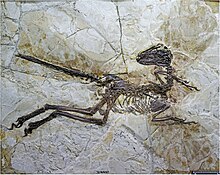Zhenyuanlong
|
Zhenyuanlong Temporal range: Early Cretaceous 125 Ma |
|
|---|---|
 |
|
| Fossil specimen | |
| Scientific classification | |
| Kingdom: | Animalia |
| Phylum: | Chordata |
| Class: | Reptilia |
| Clade: | Dinosauria |
| Order: | Saurischia |
| Suborder: | Theropoda |
| Family: | †Dromaeosauridae |
| Genus: |
†Zhenyuanlong Lü & Brusatte, 2015 |
| Species: | †Z. suni |
| Binomial name | |
|
Zhenyuanlong suni Lü & Brusatte, 2015 |
|
Zhenyuanlong (meaning "Zhenyuan's dragon", from Chinese Pinyin "dragon") is a genus of dromaeosaurid dinosaur from the Yixian Formation of Liaoning, China. It lived during the Aptian age of the early Cretaceous period, approximately 125 million years ago. It is known from a single specimen belonging to the species Zhenyuanlong suni. This type specimen preserved a nearly complete skeleton that contains traces of feathers, including long tail feathers and large wings. In addition to further complicating diversity of Liaoning dromaeosaurids, this specimen provides the first evidence of well-developed pennaceous feathers in a large, non-flying dromaeosaur, raising the question of what function such wings would serve.
Zhenyuanlong suni was a mid-sized dromaeosaurid comparable in length to the similar Tianyuraptor. The fossil skeleton is nearly complete but lacks the last half of the tail, giving the specimen a preserved length of 122.6 centimetres (4.02 ft). Based on comparison to the complete skeleton of Tianyuraptor, it has been estimated that the skeleton of Zhenyuanlong would have been about 165 centimetres (5.41 ft) long when complete. With the added length of long tail feathers, the animal was perhaps up to 2 metres (6.6 ft) in life. The fossil represents a subadult individual, as shown by the fusion of the neural arches having been progressed into the sacrum.
Its overall proportions are comparable to Tianyuraptor, a dromaeosaurid from the same formation, and it bears many anatomical similarities to the other Liaoning dromaeosaurids. The skull is well-preserved and similar in shape to that of Tianyuraptor and the related Sinornithosaurus. Its sacrum consists of six vertebrae, four of which are clearly fused, and its tail includes the network of bony support rods typical of dromaeosaurs, as well as middle caudal (tail) vertebrae that are somewhat elongated compared to most other dromaeosaurs. Both pectoral girdles are preserved and the specimen shows non-fused sternal plates. Its leg proportions are similar to other Liaoning dromaeosaurs, with its tibiotarsus longer than the femur at a ratio of around 1.30. This large ratio is typical of Liaoning dromaeosaurs but differs from most other dinosaurs in this group.
...
Wikipedia
